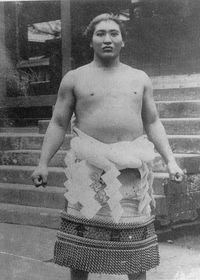Nishinoumi Kajirō III
| 西ノ海 嘉治郎 Nishinoumi Kajirō III | |
|---|---|
 | |
| Personal information | |
| Born | Isesuke Matsuyama November 2, 1890 Kagoshima, Japan |
| Died | July 28, 1933 (aged 42) |
| Height | 1.83 m (6 ft 0 in) |
| Weight | 116 kg (256 lb) |
| Career | |
| Stable | Izutsu |
| Record | 176-69-121-4draws-2holds (Total) 134-60-116-2draws-2holds (Makuuchi) |
| Debut | January 1910 |
| Highest rank | Yokozuna (April 1923) |
| Retired | October, 1928 |
| Championships | 1 (Makuuchi) 1 (Jūryō) 1 (Makushita) 1 (Jonidan) |
| Gold Stars | 1 (Ōtori) |
| * Up to date as of September 2007. | |
Nishinoumi Kajirō III (西ノ海 嘉治郎, November 2, 1890 – July 28, 1933) was a sumo wrestler. He was the sport's 30th Yokozuna.
Career
He joined Izutsu stable and made a debut in January 1910. He was promoted to the top makuuchi division in January 1916. He was promoted to ōzeki in January 1922.
After Ōnishiki Uichirō left the sumo world, there remained only one yokozuna Tochigiyama in Tokyo sumo at that time. Tokyo Sumo Association wanted to get one more yokozuna. Although he didn't record good results, he was awarded a yokozuna licence in April 1923. He was promoted to that rank without winning any championships in top makuuchi division. Therefore, his promotion was controversial, although championships (yūshō) before January 1926 were officially awarded by not the Sumo Association but a newspaper, the Osaka Mainichi Shimbun.
He won his only championship in May 1925. He was striken down by heart disease in November 1925 and was absent from next tournament. His strength declined and he retired in October 1928. In the top makuuchi division, he won 134 bouts and lost 60 bouts, recording a winning percentage of 69.1.
Top division record
- In 1927 Tokyo and Osaka sumo merged and four tournaments a year in Tokyo and other locations began to be held.
| - | Spring Haru basho, varied |
Summer Natsu basho, varied |
|---|---|---|
| 1916 | East Maegashira #13 9–1 |
East Maegashira #3 2–3–5 |
| 1917 | West Maegashira #5 4–5–1 |
West Maegashira #6 5–4 1d |
| 1918 | East Maegashira #3 7–2–1 |
East Sekiwake 2–8 |
| 1919 | East Maegashira #3 5–4–1 |
East Maegashira #6 9–1 ★ |
| 1920 | East Komusubi 7–3 |
West Komusubi 5–2–3 |
| 1921 | West Sekiwake 7–2 1h |
East Sekiwake 8–2 |
| 1922 | West Ōzeki 7–3 |
Sat out |
| 1923 | West Ōzeki 8–1 1d |
East Yokozuna 5–2–4 |
| 1924 | Sat out | West Yokozuna 5–2–3 1h |
| 1925 | West Yokozuna 9–2 |
East Yokozuna 9–2 |
| 1926 | Sat out | West Yokozuna 9–2 |
| - | Spring Haru basho, Tokyo |
March Sangatsu basho, varied |
Summer Natsu basho, Tokyo |
October Jūgatsu basho, varied | ||
|---|---|---|---|---|---|---|
| 1927 | East Yokozuna 3–2–6 |
Sat out | East Yokozuna 1–2–8 |
West Yokozuna 1–2–8 |
||
| 1928 | West Yokozuna 7–3–1 |
Sat out | Sat out | East Yokozuna Retired 0–0 |
||
| Record given as win-loss-absent Top Division Champion Top Division Runner-up Retired Lower Divisions Key: ★=Kinboshi(s); d=Draw(s) (引分); h=Hold(s) (預り) |
||||||
See also
- Glossary of sumo terms
- List of past sumo wrestlers
- List of sumo tournament top division champions
- List of sumo tournament second division champions
- List of Yokozuna
References
- ^ "Nishinoumi Kajiro Rikishi Information". Sumo Reference. Retrieved 2007-10-04.
External links
